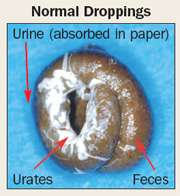Conversion Quick Tips for Feeding Harrison’s Bird Foods
Bake the Change -Bird Bread Mix: Utilize HARRISON’S BIRD BREAD MIX as a powerful conversion tool. Incorporate the bird’s current food into the mix and bake it into bread. Gradually decrease the amount of the original food and replace it with the appropriate Harrison’s formula. (Refer to Diet Conversion)
The Art of JUMPSTART: For hesitant birds, substitute the bird’s regular seeds with JUMPSTART GREY MILLET for 3-5 weeks, then start the conversion process. Feeding a certified organic seeds diet can help the bird feel better and be more receptive to trying new foods. JUMPSTART OMEGA, a nutritious source of omega fatty acids, can be included at 5% of the overall diet for life.
Fly the Coop – Environment Change: Try relocating your bird to a different enclosure, use a box, or something like an aquarium, or another cage. Removing distractions like toys, perches, and bowls, and offer the appropriate HIGH POTENCY™ formula on a solid, flat surface like the floor of the enclosure.
Mirror Mirror on the Floor: Sprinkle the HIGH POTENCY formula over a mirror or a sheet of white paper placed at the bottom of the enclosure. This technique works particularly well for budgies and cockatiels, as the bird might eat to compete with its perceived-rival reflection. A white paper background can also draw attention to the food particles and create more interest.
Gradual Weaning from Seeds: Slowly reduce the bird’s seed intake. Start by replacing the High Potency Formula selected in the bird’s primary food bowl first thing in the morning when the bird wakes up. Offering seeds or the previous diet from the food bowl for only one hour in the evening. Then, remove the seeds or previous food and replace them with the HIGH POTENCY™ formula. The following day, following the same route only reducing the time in the evening for seeds or the previous diet to 30 minutes in the evening. On the third day, decrease the time to 15 minutes, in the evening. Finally, offer only HIGH POTENCY™ on the fourth day.(Note: This method is not suitable for budgies or finches or birds weighing under 50 grams and ALWAYS watch the birds droppings for food consumption in the feces volume and frequency)
Mind Over Mealtime Feeding: Serve the bird’s food on a plate and simulate eating by moving it around with your finger or a spoon in front of your bird. Sharing a make-believe meal with your bird buddy might just be the trick.
Power Treats and Mash: Introduce POWER TREATS™, PEPPER Formula™, OR HIGH POTENCY MASH™. These tasty options give them something to tweet about. Power Treats can be crushed into beak-size pieces for smaller birds and they can entice your bird to try new foods.
Warm or Moistened Food: Slightly heat or moisten the HIGH POTENCY™ formula with a small amount of organic fruit juice or other liquids to encourage initial acceptance.
Veterinary Supervision: Arrange a supervised diet change with your veterinarian. Some birds may not recognize Harrison’s Bird Foods as food, and having a professional monitoring the process can ensure your bird’s diet conversion success.
Try, Try Again: If the initial conversion attempts are unsuccessful, you can temporarily revert to the familiar food and then try again. Remember, the effort is worthwhile for the long-term health of your bird.
Up Close and Personal Bird Watching: Monitor your bird’s weight in grams with a gram scale and its body condition, attitude, and droppings*.
*Reading Your Bird’s Droppings (Waste Whispering):
To assess your bird’s poo, use clean white paper or other smooth surfaces for collection.
The droppings should appear soft and brown when the bird consumes a formulated diet but might be abnormally dry and display colors like black, yellow, or green with a seed-based diet. Signs of increased urine volume can result from consuming too many fruits and vegetables. Normal urates, the creamy white waste from the kidneys, are typically found suspended in liquid urine or wrapped around the feces. Any color change in the urates indicates something abnormal. Sick birds might exhibit alterations in the volume, color, consistency, or frequency of their droppings. Note that egg-laying females, baby birds on hand-feeding formulas, and nervous or ill birds may produce larger droppings, or experience increased urine output. (Add our image of normal droppings).


